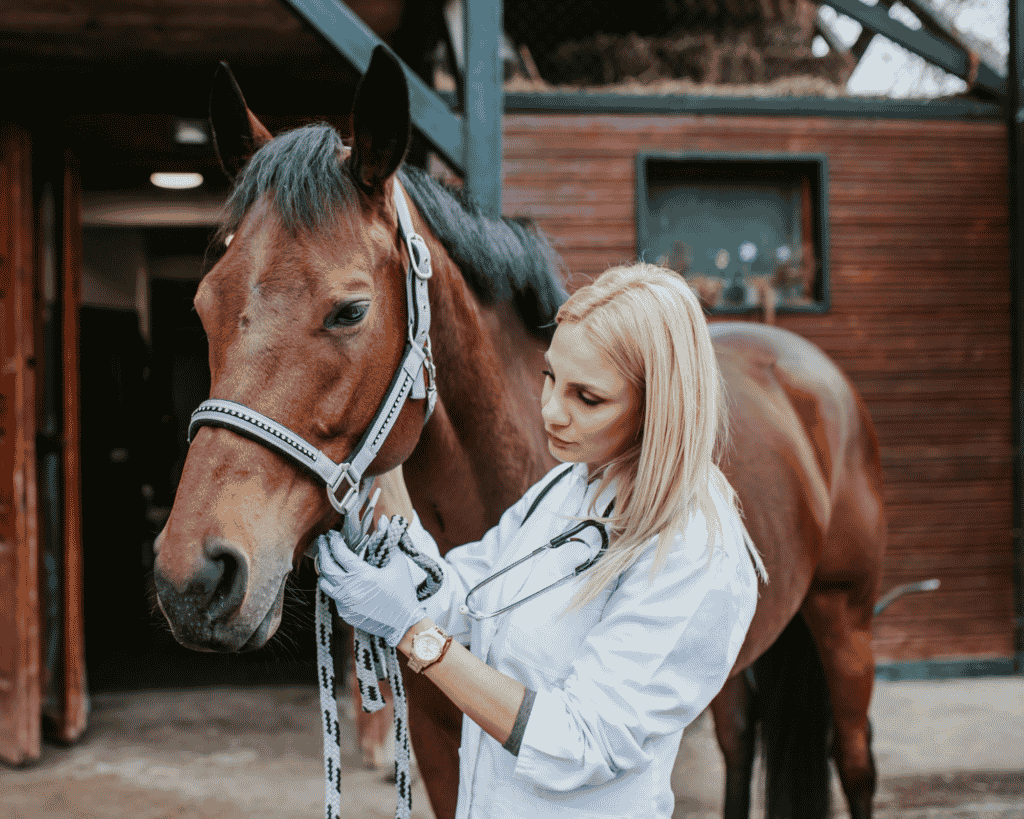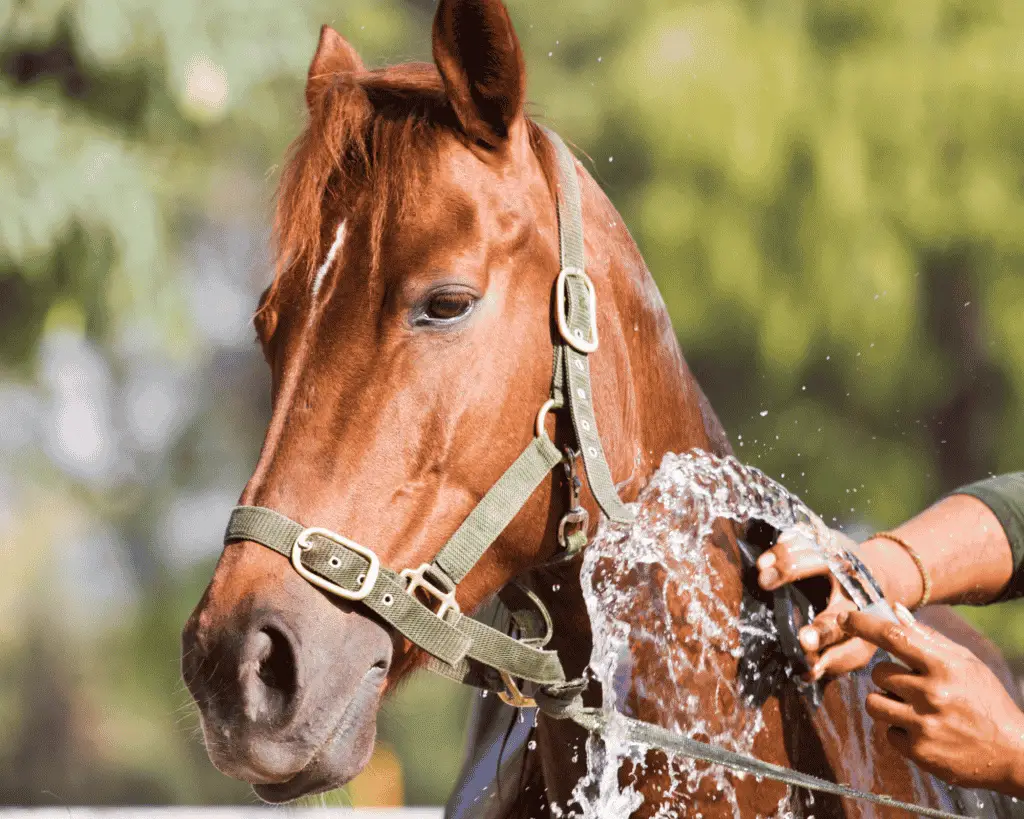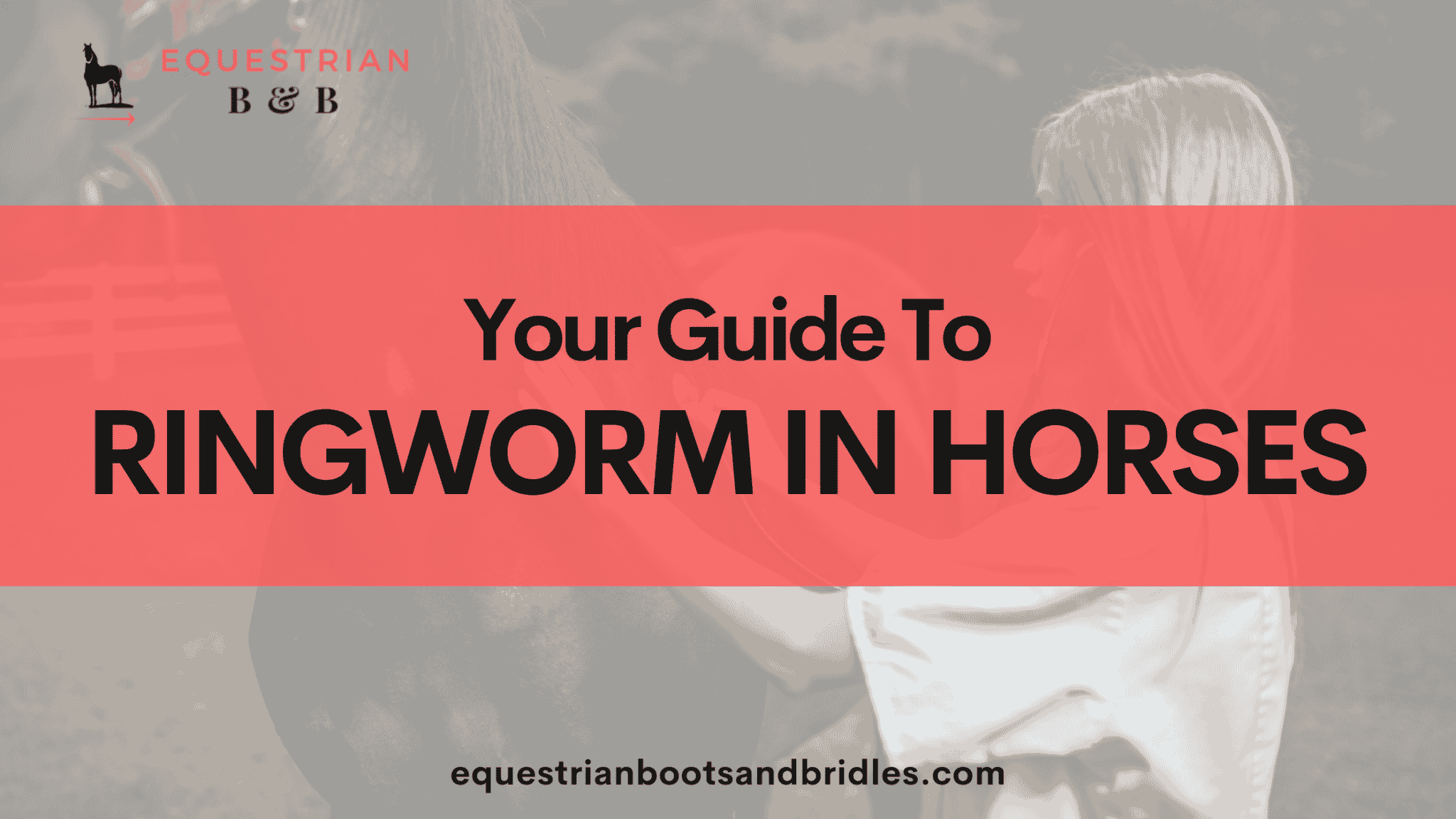Ringworm gets its name from its appearance as a ring of bare skin on a horse’s haircoat. Its name suggests the appearance of a worm in the shape of a ring, but it’s actually a fungus that’s picked up from the dirt, contaminated grooming tools, tack, and even stalls. This skin-loving fungus is highly contagious and can quickly damage a horse’s haircoat.
No horse owner wants to see their horse develop ringworm, especially if the show season is in full swing. The ringworm fungus spreads easily and requires a horse to undergo quarantine while the fungal infection is active. Care has to be taken to prevent transmission from one horse to another, but ringworm can still spread despite the best attempts to keep it under control.
Ringworm is tough to avoid due to the fact it likes to live in conditions that barns and stables provide. The use of fungicides and regular cleaning routines can go a long way toward preventing the ringworm spores from taking hold, but it’s not a guarantee that a horse won’t pick it up at some point. When a horse gets a case of ringworm, it’s time to get tough and do everything possible to resolve the condition as well as prevent its spread.
P.S. This article is for informational purposes only and you should always consult with your veterinarian when it comes to the health of your horse.
What is Ringworm?
Ringworm is a fungal infection of the skin that’s caused by one of several species of dermatophytes. The word dermatophyte literally means “skin-loving”, and this fungus most definitely loves skin. The types of fungi that cause equine ringworm include Microsporum and Trichophyton, and they can infect other species as well.
Ringworm spores are capable of surviving in an environment for up to 20 years, making it difficult to control, much less eradicate. It’s impossible to identify a source of ringworm because it’s so pervasive in a barn environment. You won’t know where your horse picked up the fungus because you can’t see it with the naked eye.
The name ringworm suggests that the appearance of the condition is in the shape of a circle, but ringworm lesions can actually take on any shape. The spores are transmitted through contact, and they attach to the hair in the pattern where they landed.
The only way to effectively deal with ringworm and reduce its presence is to treat the condition as soon as it becomes visible. Treatment of ringworm reduces spore shedding, which leads to fewer spores in the barn and around the property, and lowers the risk of another horse becoming infected.

How Ringworm Happens
As previously mentioned, ringworm is a fungus that’s found in dirt and wood. Ringworm spores reach a location through various means, and you won’t know it’s there until a horse develops the condition. The most common method of transmission is from one horse to another, followed by brushing against something made from wood. Ringworm spores are hardy and resistant to mother nature’s attempts to break them down.
An infected horse can roll in the dirt or rub against a wooden structure or post and deposit the spores. Another horse can come along and pick up the spores simply by rolling around in the now contaminated soil or rubbing up against the same spot that the infected horse touched. It can take up to three weeks for the signs of ringworm to become apparent after a horse has been infected.
The spores lie dormant until they find a host to cling to and propagate. Once the spores find a host, they take hold of the base of the hair shaft where its favorite food, keratin, is the most abundant. Keratin, a hair protein, is vital to the well-being of every hair shaft. Ringworm deprives the hair shaft of its keratin and causes it to become brittle and weak. The hair breaks off just underneath or at the surface of the skin in round patches, resulting in the classic appearance of ringworm.
Signs and Symptoms of Ringworm
Ringworm in horses appears anywhere from a few days to a month after exposure. You may not know that your horse is carrying ringworm until the first signs appear.
The first signs of ringworm are typically small raised bumps with hair loss. The spots then develop into a larger spot with no hair, or a ring of bare skin in one area of the horse’s body. It then spreads to other areas of the body as it seeks out the keratin-rich section of the hair shaft. The fungus causes the hair to lose its condition, resulting in hair breakage just underneath the surface of the skin. This breakage results in a pattern of hair loss across the area where the fungus is active.
Hair that’s been affected by ringworm is fragile and easily broken off. You may also notice flakes and scales on the skin in an affected area, and the remaining hair has a stubbly appearance. A veterinarian can confirm a diagnosis of ringworm by taking a scraping of skin from a lesion and looking at it under a microscope.
An examination of the skin and hair scraping under a microscope can reveal the presence of spores that are characteristic of the fungus. If there’s uncertainty, a sample can be sent to a laboratory for cultivation and incubation. In the lab, the fungal culture is watched to see if they develop into one of the common ringworm types of fungus.
It can take a few weeks for a case of ringworm to become resolved. Treatment kills off the fungus within two weeks, but the lesions take longer to heal and regrow hair. You can usually expect to see improvement in your horse’s coat within six weeks, but some cases can take longer. The overall health of the horse plays a role in how fast the skin and hair regenerate themselves, too.

How to Prevent Ringworm in Horses
Unfortunately, it’s not easy to prevent ringworm in horses. The fact that it’s caused by fungal spores means it’s found everywhere in the environment. About the only way to prevent ringworm is to spray wood surfaces with a fungicide on a regular basis, and even then, that’s not a guarantee of prevention. (Not to mention, the over-application of fungicides may cause ringworm and other fungi to evolve and mutate, becoming fungicide-resistant.)
Ringworm also lives in the dirt, which means a horse can pick up the fungal spores when they lay down or roll around, and it’s practically impossible to prevent this.
Preventing the Spread of Ringworm in a Barn
About the only way to prevent ringworm from spreading around a barn is to quarantine an infected horse and make sure that no other horse uses the stall. Remove bedding regularly and dispose of it directly into the manure pile. Don’t share any sheets, blankets, pads, or tack with other horses. The same goes for grooming tools. Make sure to wash anything used on an infected horse with an antifungal soap.
When a new horse is introduced to the barn, it should be kept away from other horses for two to three weeks for observation and prevention of transmission of ringworm. Horses may not show signs of any type of infection right away, which is why it’s a good idea to put them in quarantine.
Anyone who handles or treats the infected horse should wear disposable gloves at all times, and dispose of the gloves when they have finished taking care of the horse. It’s important to dispose of the gloves properly and prevent the fungus from being picked up by another animal or even the wind.
Cleaning Your Horse with Anti-Fungals
The overall goal is to prevent the spread of ringworm through any means necessary. Ringworm spores primarily spread through contact with other animals, which makes preventing contact while the ringworm is active paramount. If you’re concerned about your horse developing ringworm, you can bathe them regularly with an anti-fungal shampoo to minimize the potential for an outbreak.
Feed Your Horse Supplements for a Healthy Immune System
Ringworm and other dermatological conditions thrive on horses who have a lowered immune system. Supplementing a horse’s diet with vitamins and minerals can help them resist a case of ringworm or make it easier for them to fight off the fungus if it takes hold.
Types of Treatment for Ringworm in Horses
As previously mentioned, ringworm will usually resolve itself in about 6 to 12 weeks, but this is not an ideal way to treat the condition as it’s highly contagious. The longer a horse deals with ringworm, the more likely it is to infect other horses and spread the spores around a barn. Ringworm also disrupts hair growth and creates a patchy-looking coat that’s not pleasant to look at.
Treatment for ringworm in horses consists of using an anti-fungal shampoo or medication directly on top of the affected area over a period of time. Clipping the hair away from the site of infection allows the anti-fungal to more effectively reach the fungus and kill it off. Make sure to follow the directions on the medication, and give it time to soak in.
You’ll need to remove scabs, dead hair, and scurf from the area as you clean. Don’t pick them off when they’re dry, however, as this can hurt your horse. You can apply mineral oil to the area and let it soften the crust and scabs. Another technique is to use a mild detergent and a soft toothbrush to gently scrub away the material. Once everything is pliable, you can gently pull them away and expose the area for treatment.
Removing the scabs is an important part of treatment, but if your horse is reacting poorly to your attempts or the skin is raw, stop your efforts for now. The skin will start to heal with topical treatment, and you’ll be able to remove the scabs as your horse’s sensitivity levels return to normal.
After the treatment has been completed, it’s time to wash it out and remove all debris. Make sure to dry your horse’s skin and hair after treatment, as the fungus thrives in a damp environment. Drying off your horse also helps resolve the condition more quickly.

Understanding the Difference Between Ringworm and Rain Rot
Ringworm and rain rot can have similar appearances and presentations, but they have entirely different causes and treatments. Rain rot is the result of an overgrowth of bacteria, while ringworm is caused by fungus. It’s not unusual for one to be mistaken for the other, and sometimes a vet is needed to diagnose the condition and prescribe appropriate treatment.
Rain rot happens when weather conditions are ideal for stimulating a normally dormant skin bacteria to grow. It requires a combination of enough rain to soak a horse for an extended period of time and accompanied by humid conditions after the rain. The skin bacteria reproduce rapidly in response to these conditions and the signs show up the day after a horse has spent time out in the rain.
In contrast, ringworm is a slow-growing fungus that takes up to three weeks to become visible. Like rain rot, it causes the hair follicles to die off, but it feeds off the keratin in the hair as opposed to choking off the hair root via a pustule.
You can read more about rain rot in this in-depth article.
FAQs About Ringworm
What are the equine ringworm stages?
Ringworm has an incubation period of anywhere from one to four weeks. You may not know there’s a ringworm infection on your horse until the hair falls out and leaves behind a raw patch of skin.
Can I catch ringworm from my horse?
There’s no denying the fact that ringworm is highly contagious, but the horse-to-human transmission of the fungus is unlikely. Always make sure to wear gloves while you’re treating a case of ringworm on your horse and dispose of them properly to avoid contact.
How contagious is ringworm for horses?
Ringworm is highly contagious for horses, which is why caution and care need to be taken when a horse has a confirmed case. It doesn’t take much for the spores to travel to another horse and take up residence.
How can I be sure it’s ringworm and not rain rot?
Ringworm and rain rot have a similar appearance at first glance, but they’re distinct from each other when you know what to look for. Rain rot consists of pustules that make clumps of hair stand up prior to falling out, while ringworm causes a skin lesion as a result of the hair being decimated at the skin level.

